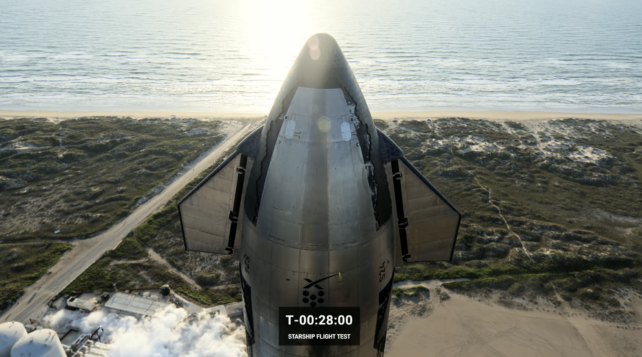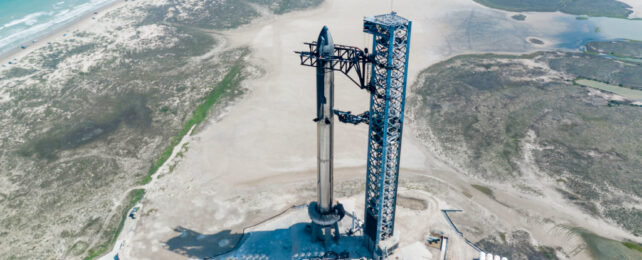SpaceX attempted the first test flight of the mega rocket that could one day take us to Mars on Monday morning.
Just after T-9 minutes, the launch was transitioned to a wet dress rehearsal due to pressurization issues.
This means the rocket didn't launch, but the launch process continued until T-40 seconds for the rest of the countdown procedure to be fully tested.
Once launched, Starship will be the tallest and most powerful fully reusable rocket ever flown.
But even ahead of Monday's scrub, SpaceX founder Elon Musk gave test launch only a 50 percent chance of success.
The launch was scheduled for 0820 local time (1320 UTC) on Monday 17 April. You can watch the whole thing in the livestream below.
https://www.youtube.com/watch?v=L5QXreqOrTA
The next launch attempt will be in at least 48 hours once the fuel has been recycled.
This post was being updated live throughout the launch attempt, all times below are in UTC.
13.21: Okay, that's all for today! Let's hope for a more successful launch in the next attempt. We'll see you all then.
13.19: The countdown is going ahead, but sadly we won't be seeing any fire today. The launch has been scrubbed for today and there'll be a minimum of 48 hours before the fuel can be recycled and SpaceX will reattempt launch.
13.12: Due to pressurization issues, it appears today's test will become a wet dress rehearsal, which means the countdown will keep going until T-40 seconds to fully validate the launch process. But at this stage it's likely launch will not go ahead.
A pressurant valve appears to be frozen, so unless it starts operating soon, no launch today
— Elon Musk (@elonmusk) April 17, 2023
13.10: T-10 minutes, here we go!
13.05: The first stage team is troubleshooting a pressurization issue at the moment, but for now countdown is still going ahead.
12.58: Reminder.
With a test such as this, success is measured by how much we can learn, which will inform and improve the probability of success in the future as SpaceX rapidly advances development of Starship pic.twitter.com/2tf4jx3qRL
— SpaceX (@SpaceX) April 17, 2023
12.55: Look at that beauty, ready to go!

12.45: We're getting a rundown on all the different parts of Starship and some information on how the rocket will land in future. But for today, it'll be a hard water landing.
12.35: Here we go, the livestream has started and it's looking go for launch!
12.24: Starship and Super Heavy are both being fuelled, and launch time has been updated to 13.20 UTC. One hour to go!
Cryogenic propellant load of Starship is underway, liftoff in T minus 1 hour
— Elon Musk (@elonmusk) April 17, 2023
"I'm not saying it will get to orbit," Musk said at the Morgan Stanley Conference on March 7, "but I am guaranteeing excitement!"
"I think it's got hopefully about a 50 percent chance of reaching orbit," he added, in reference to the first test launch.
But he did give the rocket an 80 percent chance of successfully reaching orbit by the end of the year.
Starship is an incredible 40 stories tall. It consists of the spacecraft – a 50-meter (164-foot) reusable crew and cargo capsule – stacked on top of a 70-meter (230-foot) tall Super Heavy rocket booster.
A successful test firing of the 33 Raptor engines on the booster was carried out in February, but the Super Heavy booster was anchored down the whole time.
SpaceX only got permission last Friday from the Federal Aviation Administration to actually launch Starship in its full configuration.
Starship fully stacked at Starbase pic.twitter.com/UW4V3ZRcLR
— SpaceX (@SpaceX) April 15, 2023
For this first launch, the aim is simply to get into Earth's orbit. SpaceX won't attempt to land or reuse Starship or the Super Heavy Booster.
But the ultimate goal is for Starship to become a reusable rocket just like Falcon 9, one that can take humans to other planets and back again.
Of course, Falcon 9 took many, many failed attempts, and a whole lot of landing pad explosions, before it could successfully take off and land over and over again.
Now the rocket is used to regularly transport people and objects to and from the International Space Station.
NASA is also working on its own Mars heavy rocket, the Space Launch System (SLS) which was successfully launched for the first time in November.
The space agency's goal is to take astronauts to lunar orbit by November 2024.
Starship will be more powerful than SLS, and also reusable. SpaceX's goal is to put a Starship into orbit and then refuel it with another Starship, so it can continue onto other planets.
"Full rapid reusability … is the profound breakthrough that is needed to extend life beyond Earth," Musk said in the Morgan Stanley Conference interview. "It lowers the cost of access to space by orders of magnitude."
"This vehicle could make life multiplanetary. That's a really big deal."
